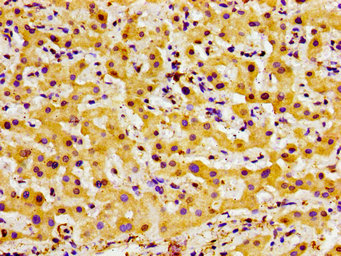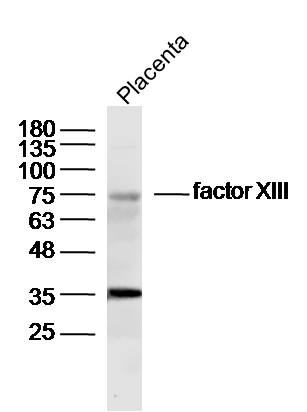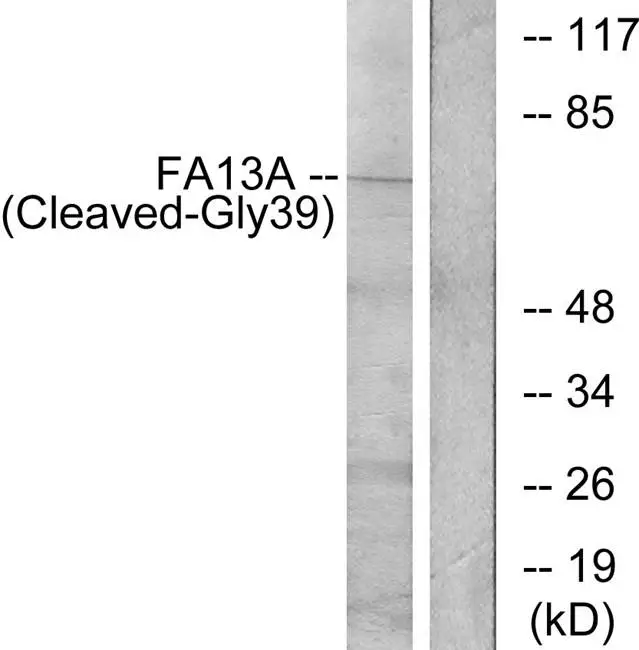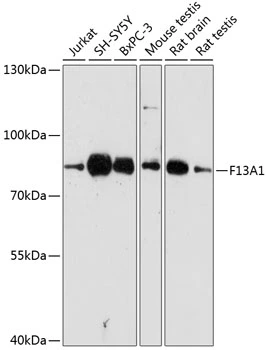
Analysis of Protein Array containing more than 19,000 full-length human proteins using Factor XIIIa Mouse Monoclonal Antibody (F13A1/1448). Z- and S- Score: The Z-score represents the strength of a signal that a monoclonal antibody produces when binding to a particular protein on the HuProtTM array. Z-scores are described in units of standard deviations (SDs) above the mean value of all signals generated on that array. If targets on HuProtTM are arranged in descending order of the Z-score, the S-score is the difference (also in units of SDs) between the Z-score. S-score therefore represents the relative target specificity of a Monoclonal Antibody to its intended target. A Monoclonal Antibody is considered to specific to its intended target if the Monoclonal Antibody has an S-score of at least 2.5. For example, if a Monoclonal Antibody binds to protein X with a Z-score of 43 and to protein Y with a Z-score of 14, then the S-score for the binding of that Monoclonal Antibody to protein X is equal to 29.
Factor XIIIa antibody [F13A1/1448]
GTX34714
ApplicationsFlow Cytometry, ImmunoFluorescence, Western Blot, ELISA, ImmunoCytoChemistry, ImmunoHistoChemistry, ImmunoHistoChemistry Paraffin, Other Application
Product group Antibodies
TargetF13A1
Overview
- SupplierGeneTex
- Product NameFactor XIIIa antibody [F13A1/1448]
- Delivery Days Customer9
- Application Supplier NoteWB: 1-2microg/ml. ICC/IF: 1-2microg/ml. IHC-P: 1-2microg/ml for 30 min at RT. FACS: 1-2microg/106 cells. ELISA: 2-4microg/ml (for coating). *Optimal dilutions/concentrations should be determined by the researcher.Not tested in other applications.
- ApplicationsFlow Cytometry, ImmunoFluorescence, Western Blot, ELISA, ImmunoCytoChemistry, ImmunoHistoChemistry, ImmunoHistoChemistry Paraffin, Other Application
- CertificationResearch Use Only
- ClonalityMonoclonal
- Clone IDF13A1/1448
- Concentration0.2 mg/ml
- ConjugateUnconjugated
- Gene ID2162
- Target nameF13A1
- Target descriptioncoagulation factor XIII A chain
- Target synonymsF13A, coagulation factor XIII A chain, FSF, A subunit, TGase, bA525O21.1 (coagulation factor XIII, A1 polypeptide), coagulation factor XIII, A polypeptide, coagulation factor XIII, A1 polypeptide, coagulation factor XIIIa, factor XIIIa, fibrin stabilizing factor, A subunit, fibrinoligase, protein-glutamine gamma-glutamyltransferase A chain, transglutaminase A chain, transglutaminase. plasma
- HostMouse
- IsotypeIgG2b
- Protein IDP00488
- Protein NameCoagulation factor XIII A chain
- Scientific DescriptionThis gene encodes the coagulation factor XIII A subunit. Coagulation factor XIII is the last zymogen to become activated in the blood coagulation cascade. Plasma factor XIII is a heterotetramer composed of 2 A subunits and 2 B subunits. The A subunits have catalytic function, and the B subunits do not have enzymatic activity and may serve as plasma carrier molecules. Platelet factor XIII is comprised only of 2 A subunits, which are identical to those of plasma origin. Upon cleavage of the activation peptide by thrombin and in the presence of calcium ion, the plasma factor XIII dissociates its B subunits and yields the same active enzyme, factor XIIIa, as platelet factor XIII. This enzyme acts as a transglutaminase to catalyze the formation of gamma-glutamyl-epsilon-lysine crosslinking between fibrin molecules, thus stabilizing the fibrin clot. It also crosslinks alpha-2-plasmin inhibitor, or fibronectin, to the alpha chains of fibrin. Factor XIII deficiency is classified into two categories: type I deficiency, characterized by the lack of both the A and B subunits; and type II deficiency, characterized by the lack of the A subunit alone. These defects can result in a lifelong bleeding tendency, defective wound healing, and habitual abortion. [provided by RefSeq, Jul 2008]
- Storage Instruction-20°C or -80°C,2°C to 8°C
- UNSPSC12352203

![WB analysis of recombinant Factor XIIIa protein and HeLa cell lysates using GTX34714 Factor XIIIa antibody [F13A1/1448]. WB analysis of recombinant Factor XIIIa protein and HeLa cell lysates using GTX34714 Factor XIIIa antibody [F13A1/1448].](https://www.genetex.com/upload/website/prouct_img/normal/GTX34714/GTX34714_20200115_WB_1864_w_23060801_420.webp)



![IHC-P analysis of human placenta tissue using GTX21834 Factor XIIIA antibody [AC-1A1].](https://www.genetex.com/upload/website/prouct_img/normal/GTX21834/GTX21834_20191203_IHC-P_88_w_23060620_681.webp)
![IHC-P analysis of human placenta using GTX01879 Factor XIIIa antibody [E980.1]. The target signal localized in the Hofbauer cells of the placental villi.](https://www.genetex.com/upload/website/prouct_img/normal/GTX01879/GTX01879_20200811_IHC-P_90_w_23053121_652.webp)


